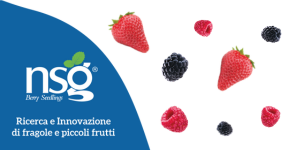The regular inclusion of plant-based foods, particularly fruit, is globally recognized as fundamental for a balanced and healthy diet, contributing to the reduction of several chronic diseases such as inflammation, cancer, diabetes, and cardiovascular disorders.
Among these, berries hold a prominent position as concentrated sources of energy, nutrients, vitamins, essential minerals, and antioxidants.
The value of blackberries
In this context, the blackberry, fruit of the historical shrub Rubus fruticosus L. (family Rosaceae), stands out for its nutritional and phytochemical profile. Presumably native to Armenia, the blackberry is now distributed worldwide and appreciated for its delicious taste, pleasant aroma, and appealing appearance.
It is considered a functional food, not only for fresh consumption but also as an ingredient in bakery products, salads, jams, preserves, and even as a source of natural colorants.

Quality factors
The blackberry (Rubus fruticosus) is a perennial bushy shrub, usually thorny in wild varieties but with many cultivated ones that are thornless. The fruit is an aggregate of drupelets that turn from green to red and finally to black or dark purple as they ripen.
Physico-chemical characteristics are key parameters that define the quality of the fruit and its derived products. Quality is influenced by several agro-geoclimatic factors, including cultivar, environmental conditions, agronomic practices, harvest time, postharvest storage, and processing techniques.
The color of the fruit and juice is an important commercial parameter, as consumers often assess the product based on its visual appearance. This color is due to natural pigments, whose intensity depends on factors such as ripeness and climate conditions.
The optimal flavor of these berries is determined by the balance between sugars and organic acids. Total soluble solids (TSS), which represent the sugar content, and titratable acidity (TAc) respectively contribute to sweetness and acidity.
It has been observed that, in general, wild genotypes tend to have a lower average fruit weight than cultivated varieties but may exhibit a higher average TSS percentage.
Nutritional composition
Blackberries are a concentrated source of valuable nutrients. Their nutritional profile highlights the presence of carbohydrates, vitamins, minerals, and dietary fiber. Like other berries, they have a low calorie count, low energy density, and reduced fat and protein content (generally below 1% and 3.5%, respectively).
Among minerals, blackberries are particularly rich in potassium, an element that can help reduce the risk of kidney stones, bone loss, and hypertension.
In terms of vitamins, blackberries are an excellent source of Vitamin C (ascorbic acid), a water-soluble vitamin found in high amounts in fruits with a water content above 50%.
They also contain vitamins A, E, and folic acid. The sufficient presence of folic acid and ascorbic acid suggests the potential use of blackberries in nutritional support programs and diet therapy aimed at preventing lifestyle-related diseases such as diabetes mellitus and cancer.
Sugars are the main source of energy in the fruit. In blackberries, fructose predominates, followed by glucose, while sucrose is present in much smaller amounts.
The high concentration of fructose, being sweeter than glucose, is a desirable organoleptic trait.

Phytochemistry and antioxidants
The health benefits attributed to berries are linked to their rich phytochemical profile, which includes phenolic acids, flavonoids, carotenoids, and anthocyanins.
Blackberries are widely regarded as powerful scavengers and inhibitors of free radicals due to their high phenol, flavonol, and anthocyanin content, acting as a rich source of natural antioxidants.
1. Polyphenols and Flavonoids: Phenolic acids such as ellagic, gallic, caffeic, and p-coumaric acids have been identified. Flavonoids include quercetin, hyperoside, kaempferol, and catechin.
Comparative studies have shown that wild cultivars of R. fruticosus may contain up to twice the amount of ellagic acid as cultivated genotypes, highlighting the importance of biodiversity.
2. Anthocyanins: These flavonoid derivatives are water-soluble natural pigments responsible for the dark color. The primary anthocyanin found in blackberries is cyanidin-3-O-glucoside.
Animal model studies suggest that anthocyanins possess anti-carcinogenic, anti-inflammatory, anti-obesity activities, and play a role in the prevention of diabetes and cardiovascular diseases.
3. Carotenoids: Fat-soluble pigments with immune-enhancing properties. Lutein, β-cryptoxanthin, lycopene, zeaxanthin, β-carotene, and α-carotene have been isolated.
β-carotene, in particular, can be converted into Vitamin A, giving the fruit an important nutritional role as an antioxidant.
Uses and applications of blackberries
The healing properties of these berries are attributed to their bioactive compounds and antioxidant components. The most studied activities of blackberries include antimicrobial, antioxidant, anti-inflammatory, and anti-cancer effects.
• Antioxidant and Anticancer Activity: The high antioxidant capacity, largely due to anthocyanins, has demonstrated chemopreventive effects, such as inhibiting esophageal tumors in treated rats.
Cyanidin-3-O-glucoside has been shown to inhibit neoplastic transformation, metastasis, and induce apoptosis (programmed cell death) in cancer cells.
• Anti-inflammatory Activity: The consumption of berries has been found to reduce inflammation risk. An aqueous extract of the fruits exhibited strong anti-inflammatory activity in vitro.
• Antidiabetic Activity: The blackberry is considered a potential dietary therapy for Diabetes Mellitus (DM).
The anti-hyperglycemic efficacy of leaf extracts has been observed in rats. Furthermore, the inhibition of intestinal enzymes α-glucosidase and α-amylase, crucial for slowing carbohydrate breakdown, suggests potential use as an antidiabetic remedy.
• Cosmetic and Industrial Uses: The oil extracted from pomace, rich in α-tocopherol (known for its biological activity), indicates potential use in the food, pharmaceutical, and cosmetic industries.
Thanks to its antioxidant properties and distinctive fragrance, blackberry extract is used in the cosmetic industry for skincare products targeting aging, wrinkles, and issues such as acne.
Strategic role in the modern diet
The blackberry stands out as a fruit rich in essential nutrients such as vitamins, minerals, antioxidants, and dietary fiber. These components play a protective role against aging, inflammation, and neurological diseases.
In an era marked by increased awareness of functional foods and optimal health, the global demand for berries has risen, especially in high-income countries.
The documented therapeutic efficacy, combined with versatility of use and an outstanding phytochemical profile, gives blackberries a strategic role both in nutrition and in the development of new nutraceutical and cosmetic products.
Although further controlled clinical studies are needed to fully validate traditional claims, the growing body of evidence linking high polyphenol and anthocyanin content to tangible health benefits—such as anti-inflammatory and antidiabetic activity—highlights the relevance of these berries as pillars of a modern diet focused on wellness and prevention.
Source: Zia-Ul-Haq M, Riaz M, De Feo V, Jaafar HZ, Moga M. Rubus fruticosus L.: constituents, biological activities and health related uses. Molecules. 2014 Jul 28;19(8):10998-1029. doi: 10.3390/molecules190810998. PMID: 25072202; PMCID: PMC6271759
🫐 Well-being & Health with Berries 🍓This article is part of the editorial series Wellness & Health with Berries, which brings scientific research closer to everyday life, promoting berries as allies for well-being. The series offers clear, up-to-date, and evidence-based content designed to inform consumers and support all operators in the berry supply chain. |










